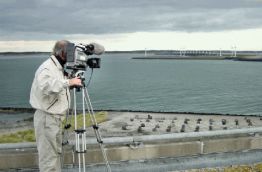Project Aim
Escape aimed to minimise the effects of flooding situations in coastal areas, through improving contingency plans, increasing public awareness and developing systems for monitoring high water and evacuation possibilities.
Project implementation and results
Activities
The project addressed the issue of flooding in coastal areas. The project is seen as very successful in achieving its objectives. The objectives mentioned in the application were: “To set-up a multi-faceted transnational disaster management strategy for flooding situations in one or more of the coastal areas of the North Sea Region. This has resulted in a transnational framework, modules and elements for the (further) development of integrated national, regional or local contingency plans, intended to reduce the effects of flooding disasters. An innovative approach for contingency plans has been assured by linking the pilot sessions of the High water Information System and the Evacuation Model. Furthermore public awareness modules have convinced people that a flood can happen every day, and what the public may expect from the government and what they can do to help themselves in case of a flood.
Implementation of this concept within other regions of the partner countries as well as within other (European) coastal regions has been stimulated by the ESCAPE-partners.” The Transnational Framework for contingency plans for example, provides a guideline and recommendations on working together in a transnational setting in the field of disaster relief.
Joint transnational strategy
Mode of cooperation
The project was characterised by a common and highly innovative approach to flood risk management, extensive transnational cooperation on the central themes, with a strong emphasis on implementation and learning from developing the demonstration sites. These sites have had the significant benefit of raising the issues of flood risk management and climate change for discussion and understanding in all partner countries.
Impact of the project
Sustainability
The principle outcome was increased public awareness and knowledge about the risk of flooding, and greater understanding of the actions that need to be taken by the general public, scientists, and politicians during a flood event. This was achieved through the establishment of a transnational disaster management strategy for flooding situations in one or more of the coastal areas of the North Sea region. The strategy included integrated national, regional or local contingency plans intended to reduce the effects of flooding disasters and will link the HIS (High Water Information System) and an evacuation model which provided a new and innovative approach to contingency plans and planning.
Dissemination
The videos/DVD’s, the ‘Watersnoodkrant’ (Flooding Newspaper), and the conferences increased the awareness for the effects and consequences of flooding and provided answers to the people and professionals on how to act and react in case of flooding. Both the HIS-model (High Water Information System), as well as the DSS-model proved to be highly innovative models that did prove their added value in the pilots performed as part of the project. |

ESCAPE looked at the consequences of flooding on the community, the economy and spatial development
Partners Ministerie van de Vlaamse Gemeenschap, BE
Carl von Ossietzky Universität Oldenburg (University of Oldenburg), DE
Province of Groningen, NL
Waterschap Zeeuwse Eilanden, NL
Gemeente Hulst, NL
Waterschap Zeeuws Vlaanderen, NL
Ministry of Traffic Danish Coastal Authority / Kystdirektoratet, DK
Environment Agency, UK
LP:
Province of Zeeland
Project Manager
Pieter Jan Mersie
Province of Zeeland Provinciehuis, Abdij 6
P.O. Box 6001 NL-4330 LA Middelburg
The Netherlands
pj.mersie@zeeland.nl
Tel: +31 118 631 349
Measure: 4.3
Start Date: 27 September 2002
End Date: 30 September 2004
ERDF Grant:
 569.088,00 569.088,00
Total Eligible Sum:
 1.138.176,00 1.138.176,00
|